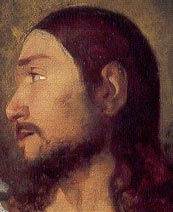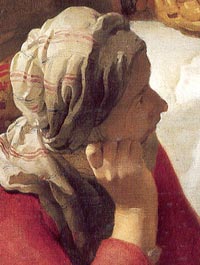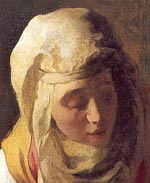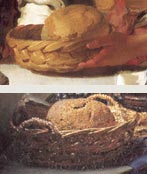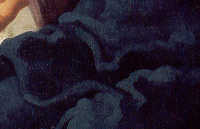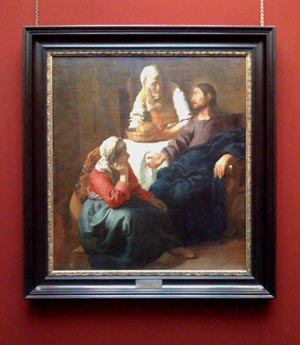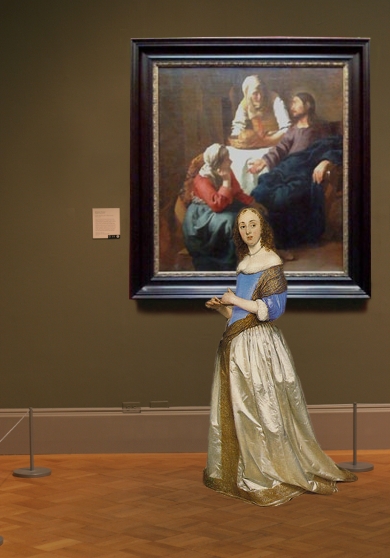Христос в доме Марфы и Марии
Христос в доме Марфы и Марии
Действующие лица Перейти к: навигация, поиск Многозначные значок для других значений Карла Великого., См. Христос в доме Марфы и Марии (значения)Прямая ссылка: САЙТ Христос в доме Марфы и Марии
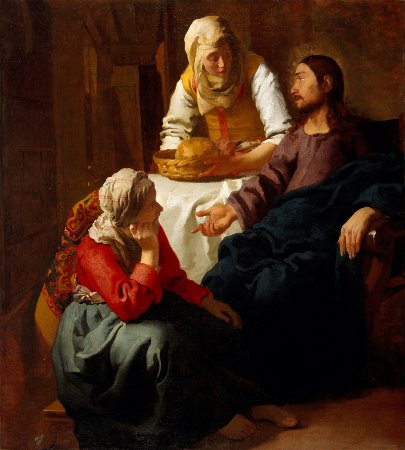
Христос, из-за мягкого свечения, который излучает со своей головы и его решительным жестом, является доминирующей фигурой в этой части. Его поза принадлежит к довольно стандартной репертуара 16th- и 17th- век итальянской живописи. Наиболее значимые сравнения могут быть сделаны с фигурами Крист в работах Андреа Vaccaro (Неаполь, Пинакотека Реджия ди Каподимонте), Алессандро Аллори (Вена, Художественно-исторический Музей) или Бернардо Каваллино (Национальный музей, Неаполь). Тем не менее, большинство историков искусства указывают на Христа кисти голландца Erasmus Quellinus в качестве наиболее вероятного модели для фигурного Вермеера.
Где Вермеер см картину Quellinus '? В то время как никакой документации не сохранилось, молодой художник мог видеть его в Антверпене на ознакомительной поездки, хотя он мог бы черпал вдохновение из многочисленных другие источники. Отец Вермеера, Ренье Янс., Который был арт-дилер и имел тесные контакты со многими художниками, могли бы обеспечить его сына широкие возможности для ознакомления с картин и гравюр многих мастеров. Еще Делфт арт-дилер, Авраам де Coge, имел обширные контакты с Ренье в течение этих лет.
Нет сомнения, самый изысканный проход в этой картине является фигура Марии, которая смотрит вверх на сидящего Христа, ожидая его комфорт и слова мудрости. Вермеера симпатичная оказание Марии, которые в данном контексте представляет собой созерцательную жизнь сосредоточена на более глубоких смыслов жизни, возможно, ударил аккорд с собственной интроспективной природе художника.
Помимо религиозного субъекта и драматическое освещение, опытный использование ракурса головы Марии предполагает, что Вермеер был, вероятно, тренировался с классически ориентированной художника.
С технической точки зрения, ракурс Процесс нанесения линейной перспективы для одного объекта делает его более или менее сжатым. Это был один из традиционных навыков, необходимых любой истории живописца. Ракурс является особенно эффективным для повышения впечатление трехмерного объема и создания драмы в картине.Эффект ракурса может быть очень трудно получить, особенно при составлении сложных анатомических особенностей.
Пожалуй, одним из самых известных примеров ракурсе можно найти в Мантеньи Оплакивание на Dead Христос . На первый взгляд, Картина, кажется, поразительно реалистично исследование в ракурсе. Тем не менее, тщательная проверка показывает, что Мантенья уменьшил размер ноги фигуры так, чтобы они не охватывают слишком много тела были они были должным образом представлены. Использование Вермеера ракурса менее очевидно, чем фигуры Mantagna, но это столь же эффективным, потому что он тонко усиливает пытливый взгляд Марии и без подавляющее общую натуралистическое прочтение картины.
Хотя несколько не хватает в психологической глубине, оказание трех библейских персонажей демонстрирует твердое понимание анатомии и технике живописи, которая, возможно, была, в конце концов, Основная цель молодого художника в такой требовательной, масштабной работы. Вместо наблюдения, художник, кажется, воспользовался хорошо создана живописные конвенций передать отношение Марты, например, риторически поднял брови и пухлые губы. Ее разочарованы, опустив взгляд контрастирует с головой и оставил в силе надежды взглядом Марии.Сыпучий манера письма головных уборов женщин и резкое упрощение анатомических особенностей предать почти маньеризма подход.
Некоторые критики отметили некоторое сходство между бюстом Доярка , и эта цифра, которая может или, возможно, не намеренно.
Эта работа акций маленькие с простой характеристики зрелого работы Вермеера, один из которых был оказание конкретных текстур.Житницей в (внизу), окрашенные всего лишь несколько лет спустя, оказывается с обсессивно внимание непростую teture из ржание и сложной конструкции корзины. Для сравнения, корзина состоится Марта (вверху) только вкратце обозначается числом самодовольных brustrokes. То же самое мелкое лечение также зарезервированы для драпировки фигур. Складки указаны с сыпучих мазками, которые не предполагают, объем или конкретного вещества.
Восточный ковер, который появляется в Христос в Дом в Марта и Мэри , кажется, почти идентичны с одной представлены в дева Спит окрашены несколько лет спустя. Хотя они имеют в общем широкой, светло-оранжевого границы, заканчивающийся в бахромой, медальон в бывший желтый, в последнем зеленый. это вероятно, что Вермеер использовал один коврик в качестве модели и окрашены мнимые вариации на нем.
Наблюдая, а вдохновения фактуру этом отрывке, жизнеспособность и текстуры ковров, которые появляются в его более поздних интерьеры невообразимое.
Ракурсе прямоугольник на стене никогда не был окончательно определены. Это могут быть приняты в качестве окна или сокращенно печати.Коридор был открыт общая черта голландцев и фламандцев кухонные сцены, с которой нынешний состав получен. В любом случае, это усиливает трехмерный спад в противном случае суммарно определенной пространстве.
Сокращенно монохромные лечение интерьера характерно итальянской религиозной живописи, в котором основное внимание внимание зрителя на делах и выражений фигур, а не на среда, где разворачивается действие. Однако, как Уолтер Лидтке отметил, & rdquo; сильный спад в узком пространстве, где окна, потолочные балки, и другой двери открыты, приходит гораздо ближе к механизмы найдены в таверне интерьеров окрашенных Роттердамской художника Лудольф де Йонг в начале 1650-х годов, которые были, принятой Питер де Хох примерно в то же время.”
Успокаиваться оказание халат Христа поражает кисловатый привкус в творчестве художника, особенно по сравнению с драпировкой из ранее Диана и ей Соратники , где структура и текстура оказываются почти наивной искренностью. Кроме того, художник использует два общих и недорогие пигменты, смальты и индиго, чтобы сделать его глубокий синий цвет а его товарный знак синий ультрамарин используется практически в каждом живописи творчестве художника.
Темно углубление слева, позади стоящего Марты, скрывает коридор и приоткрыл дверь, все окрашены в узком диапазоне коричневых красок.Выемка помогает облегчить присутствие трех цифры, которые заполняют передний план композиции, оставляя точку "побега" для зрителя, рекомендованного художественных теоретиков.Конвенция открыта дверь была заметно используются в нидерландских кухонных сценах и был позже эксплуатируются более тонко в современных установок близкий коллега Вермеера, Питер де Хох.
TENELEVENTWELVETHIRTEENFOURTEENFIFTEENSIXTEENSEVENTEENEIGHTEENNINETEENTWENTYspecial topics
fact sheet
- подпись
- дата
- происхождение
- выставки
- техническое описание
- Картина с рамой
- насколько велика эта картина?
- историческая шкала
- related works 1 2 3 4 5 6 7 8 9 10 11 12
Христос в доме Марфы и Марии считается одним из самых ранних известных картин Вермеера.Сильный аргумент для его рано дата разница в живописных приемов между этой работой и своих более поздних. Ни в одной другой картине он сосредоточиться исключительно так фигур в центральный Ядро композиции. Вермеер в его зрелых работ был очень сознательным о взаимосвязи его фигур к окружающей среде, относятся не видно в этом работа.
Arthur K. Wheelock, Jr., Jan Vermeer, 1981
inscribed lower left, on bench: IVMeer (IVM in ligature)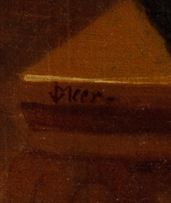
c. 1655
Arthur K. Wheelock Jr. Vermeer: The Complete Works, New York, 1997)c. 1654 - 1655
Walter Liedtke Vermeer: The Complete Paintings, New York, 2008)Поддержка живописи в порядке, простой переплетения белье с резьбой кол 12 х 17 см на. & Sup2;.Вертикальный шов в соответствии с локтя Христа. Полотно было затир выложены и оригинальные Закрепка края были удалены.Дважды площадка состоит из слоя белым мелом связан с белковой среде после чего красный слой земли. В фоновом режиме, и в затененных телесные тона Христа и Марфы красный молотый лишь частично покрыты очень тонкой коричневого глазури. Что, кажется, был глазурь на фиолетовом туники Христа сохранилась только в текстуре кистью. Основные моменты по всей драпировкой окрашены с импасто: на синем халате Христа, который был написан с индиго, смальты, и свинцово-белый, мазки около 1 см. Широкий и указывают на квадратный наконечником щетка.
Многочисленные мокрым на сырое удобства включают детали пояса Марфы, моделирование из headclothes и отделку на ковер. Скорость исполнение и текучесть краски также означается броскийс разбивкой края многие формы, такие как верхних краев таблицы и Марии профиль.
Есть несколько изменений: Профиль Христа и ухо, пальцами левой руки и край правого рукава Марты.Край некоторых форм вторгаться на соседних значительно таких областях, как верхний край халата перекрытия туники Христа. Левая рука Марии, как представляется, были закрасил Христа голубой халат.
*Йоханнес Вермеер (л.д.. кот, Национальная галерея искусств и Королевский Кабинет Картины Маурицхейс -. Вашингтон и Гаагских, 1995, под редакцией Артур К. Вилок младший)
literature
- Коллекция аббат Семья, Бристоль, гр. 1880; мебель и антиквариатом, Бристоль, 1884, продан частной вечеринке и выкупила;
- Артур Лесли колли, Лондон;
- [Форбс и Патерсон, Лондон, 1901, продана Coats];
- Уильям Аллан Пальто, Skelmorlie замок, Dalskairth, Дамфрис и Галлоуэй, Шотландия (1901-26);
- его сыновья Томас H. А. и Дж Пальта (1926-27);
- 1927 пожертвование наследников Пальта в Национальной галерее Шотландия, Эдинбург (инв. 1670).
- Лондон 1929
Выставка голландского искусства, 1450-1900. Королевская академия искусств.
147, no. 310.- Амстердам, 1935
Открывая Вермеер tentoonstelling тер herdenking ван де plechtige Ван хет Рейксмузей оп 13 Juli 1885 Государственного музея.
26-27, no. 162 and ill. 162.- Роттердам 1935
Вермеер, Oorsprong ан invloed. Фабрициус, де Хох, де Витте. Музей Ван Бойманса Бёнингена.
34, нет. 79 и заболел. 59.- Утрехт, 1952
Караваджо ан-де-Nederlanden. Центральный Музей.
57-58, no. 92 and ill. 71- Edinburgh 1992
Уильямс, J.L. голландского искусства и Шотландии.Отражение вкус. Национальная галерея Шотландии.
150-151, no. 71 and ill.- Вашингтон, Гаага 1995-1996
Йоханнес Вермеер
no.2.- Токио 2 августа – 14 декабря 2008.
Вермеер и Делфт Стиль. Метрополитен художественный музей.- The Hague 12 May – 22 August, 2010
The Young Vermeer. Mauritshuis.
26-29, no. 1 and ill.- Dresden 3 September– 28 December, 2010
The Young Vermeer. Old Masters Picture Gallery.- Edinburgh end of 2010 – Feb. 2011
The Young Vermeer. National Gallery of Scotland.
26-29, no. 1 and ill.- Rimini 21 January - 3 June, 2012
Da Vermeer a Kandinsky. Castel Sismondo.
76 and ill.
1654 vermeer's life 10 января Вермеера свидетелей акт, в котором онsigns as "Johannis Вермеера мастер художник" вместе с определенным именем капитана Ламберта Morleth. Два года назад имя Вермеера появился с двумя капитанами, а также с его родной дядя, лейтенант Balthens. Предполагается, что Вермеера был военным знакомых.
В конце апреля Вермеера снова подписывает в качестве свидетелядля признания долга от плотника в продовольственного коммерсанта.
Вермеера не свидетелем крещения его сестры Gertruy-х Ребенок в мае. Это был, скорее всего, из-за художника обращение в католичество после его вступления в брак. Даже если он был осужден на второго класса гражданства в протестантской котором доминируют Делфт, есть признаки общественного самоуважения и Вермеера был почти наверняка активно преследуют за религиозные убеждения.
Делфт, с населением 25000 до 30000 достиг пика своей художественной жизненной силы.
Потерял работу (цитируется в базовый художественной коллекции) право Юпитер, Венера и Меркурий,является приписывается Вермеера.Молодой и амбициозный художник, возможно, написал эту мифологическую сцену и свой первый из дошедших до нас работ, Diana and her Companions, в чтобы обратиться к классическим вкусам в моде в богатой аристократической суд в Гааге близкой.
По 1654-1655, с населением от 25000 до 30000, Делфт достиг пика его художественный жизненной силы . Это было вскоре распадаться, как много живописцев города уехали в поисках более привлекательных перспектив в больших, богатых городах, таких как Амстердам. К середине 1670-х гг Вермеера был один из немногих художников, которые остались. Если бы это не было для сильных личных причин, Вермеера слишком, возможно, переехал в Амстердам, как Поттер, Де Витте, Ван Aelst и De
Голландская живопись Иаков Vrel рождается. Казалось бы, наивный стиль Vrel и редкость его картины "породило слухи, что он был любителем. Ученые чаще ссылаются образом Vrel к Делфт художников, таких как Йоханнес Вермеера и Питер де Хох, но элементы в его уличных сцен может указывать на связь Гарлем, Фрисландия, Фландрия, или ниже, Рейнланд.
12 октября Делфт Thunderclap, взрыв муниципального журнала порошка, разрушает северо-восточной стороне города Делфт, убийство художник Карел Фабрициус, самый талантливый ученик Рембрандта и NBSP. Фабрициус был в его станковой живописи и его дома, студии и большинство его картин были уничтожено.Порох журнал, в котором содержится около 80000 фунтов порошка, взорвали и Quot; с таким ужасным спешке и заставить что арки небес Казалось взломать и взрыв & Quot. В том же году Фабрициус краски Щегол , который, возможно, был источником вдохновения для Вермеера.
Rembrandt paints a portrait of poet-businessman Jan Six and A Woman Bathing in a Stream.
After studying with Rembrandt, Nicholaes Maes returns to Dordrecht and specializes in intimate household scenes.
Jacob van Loo paints An Allegory of Venus and Cupid as Lady World and Homo Bulla.
12 октября, Делфт Взрывразрушает город Делфт, убивая художник Карел Fabritius.His дома, студии, и большинство из его Картины были уничтожены. В том же году он пишет Голдфинч , который, возможно, был источником вдохновения для Вермеера.
Европейская живопись и усилитель; архитектура В Нюрнберге Иоганн Амос Коменский публикует первый иллюстрированная книга для детей, Orbis sensualium Pictus.
music literature Леди Дороти Осборн играет ведущую роль в загородном постановке трагикомедии сэра Уильяма Беркли Потери Леди . В то время как театры Лондон остаются закрытыми, любительских спектаклях по-прежнему в частных домах в Англии. Как спектаклей придворных маскарадов Перед 1642, многие из этих выступлений имеется женщин, предвещая принятие профессиональных женщин исполнителей в начале эпохи Реставрации.
Roger Boyle, 1st Earl of Orrery writes Parlhenissa, a novel.
John Milton writes Defensio Secunda.
science & philosophy On November 23 Blaise Pascal, ученый и философ, подвергается мистическое переживание. Он отказывается от своей научной работы и посвящает себя философии и теологии. Его два самых известных работ датируются этим периодом: Lettres Provinciales и Ручки & eacute; ES . Он вошел в хижину в Порт-Рояль Елисейских и никогда не опубликовал в своем собственном имени. Он пришел с идеей, что вера в Бога безопаснее, чем не верить, потому что это может получить один вечную жизнь. Он был янсениста, и отклонил свободную волю в пользу предопределения.
De Circuli Magnitudine Inventa by Dutch mathematician-astronomer-physicist Christiaan Huygens, 25, attracts widespread attention.
history 10 января в России царь Александр объявил войну против Литвы и Польши, которые длится до 1667.
On April 12 Англия,Ирландия и Шотландия объединились.
7 июня Людовик XIVбудет коронован королем Франции в Реймсе.
Шах Джахан завершает Тадж-Махал . Мастер строители, каменщики, каллиграфы и т.д., наряду с более чем 20000 рабочих, работал в течение 22 лет по заказам империи Великих Моголов Шах-Джахана, чтобы завершить большой мавзолей для любимой жены шаха.
1655 vermeer's life Dec. 14, "Старший Йоханнес Reijnijersz. Вермеера мастер художник , & Quot; и его жена и Quot; Juffr. Катарина Bolnes & Quot; предстать перед нотариусом Рота, чтобы гарантировать долг 250 гульденов, что отец художника был договор. Оба Вермеера и его жена подписать документ. Появление стильного и Quot; старший и Quot; на документе безопасный признак подъема художника в социальном статусе.
dutch painting c. 1656 Jacob van Ruisdael moves to Amsterdam.
Rembrandt paints Woman Bathing in a Stream and the Polish Rider.
Pieter de Hooch, who directly influences Vermeer, joins the guild of Saint Luke in Delft, two years after he had arrived from Haarlem. He will remain in Delft and produce his finest works until 1660.
гр. 1658 <сильный> Miendert Хоббема становится учеником в Амстердаме студии Якоба ван Рейсдаля в. При осуществлении своего дела Хоббема был терпелив за все концепции. Сомнительно, либо любой ли настолько овладел, как он сделал натюрморт лесов и живой изгороди, или мельниц и бассейнов. ни мы можем верить, что он получил это мастерство иначе, чем постоянно живущая в том же районе, скажем, в Guelders или на голландском Вестфальской границы, где день за днем он может изучать ветвления и листья деревьев и подлеска embowering коттеджи и заводы, в каждой разновидности света, в каждой тени прозрачность во всех изменений, произведенные по сезонам.
european painting & architecture Luca Giordanoразвивает богатый барочный вен, вытекающих, в частности, от Рубенса. Его прозвали & Quot; Лука Фа Престо и Quot; (Лк работать быстро), потому что его огромной скоростью исполнения и огромный объем производства. Он начал в кругу Рибера, но его стиль стал более красочные под влиянием таких великих художников, как декоративных Веронезе, произведения которого он видел на своих обширных путешествиях. В самом деле, он вобрал в себя множество влияний и было сказано, чтобы быть в состоянии имитировать стили других художников с легкостью. Его работа варьировалась и в предмете, хотя он был, прежде всего, религиозный и мифологический художник. Вскоре после смерти Карла в 1700 году, Джордано, теперь богат, вернулся в Неаполь. Он провел крупные суммы в актах щедрости, и особенно либерально его бедных художников братьев. Один из его сентенций в том, что хороший художник является тот, кого общественное нравится, и что общественность привлекают больше, чем цвет дизайн. Джордано был подвергнут критике как плодовитый трейдера всех стилей, и ничего не уметь. Он рассматривается как прото-Тьеполо, реанимации, что великий манера Кортона в стиле, который бы скрасить с Тьеполо.
c. 1655 Murillo Краски жанровые сцены в Севилье, где с 1658 по 1660, он был вовлечен в создании Академии Искусство, обмена направление, в 1660 году, с архитектором, Франсиско Эрреры-эль Mozo. Это был период его наибольшей активности, и он получил многочисленные важно комиссии, среди них алтарь кусок для монастыря августинцев, картины для Санта-Мар и iacute;-ла-Бланка (завершена в 1665 году), и другие.
music Aug 13, Johann Christoph Denner, inventor of the clarinet, was born.
Giuseppe Alfiero: La fedeltà trionfante.
May 4, Bartolomeo Cristofori, inventor of the piano is born.
literature science & philosophy Blaise Pascal: Lettres provinciales, against Jesuits
Mar 25, Christiaan Huygens discovered Titan, Saturn's largest satellite. Huygens was a great figure in the fields of research into mathematical physics, astronomy and optics, and among the founders of mechanics and optical physics. He made astronomical observations about the planets, of the nebula of Orion and of the Moon, all reported in Systema Saturnium.
Hooke publishes the Micrographia.
history Pope Innocent X dies; Fabio Chigi becomes Pope Alexander VII.
Spinoza excommunicated
Apr 26, Dutch West Indies Co. denied Peter Stuyvesant's desire to exclude Jews from New Amsterdam.
Sep 26, Peter Stuyvesant recaptured Dutch Ft. Casimir from Swedish in Delaware.
The first slave auction was held in New Amsterdam (later NYC).
French society uses a clean plate for each new dish but Englishmen continue to dine off trenchers - wooden platters that give hearty eaters the name "trenchermen."
Rum from Jamaica is introduced into the Royal Navy to supplement beer, which goes sour after a few weeks at sea.
Mary and Martha are the most familiar set of sisters in the Bible. Both Luke and John describe them as friends of Jesus. Luke's story, though only four verses long, has been a source of interpretation and debate for centuries.
Preaching to the people, Jesus Christ arrived in Bethany. This town is situated not far from Jerusalem beyond the Mount of Olives where a woman named Martha welcomed him into her home. She had a sister named Mary, who sat at the Lord's feet and listened to what he was saying. But Martha was distracted by her many tasks; so she came to him and asked, "Lord, do you not care that my sister has left me to do all the work by myself? Tell her then to help me." But the Lord answered her, "Martha, Martha, you are worried and distracted by many things; there is need of only one thing. Mary has chosen the better part, which will not be taken away from her" (Luke 10:38-42).
This subject was more popular among Flemish artists than Dutch, possibly owing to the religious connotations. In the religious context of the time, the scene illustrated one of the fundamental differences between Catholics and Protestants: the latter sought salvation in action while the former placed greater value on the contemplative life.
Whereas harsh environmental conditions made travel in many European countries problematic, the level planes of the Netherlands were crossed by an extensive and well cared for network of canals that had been dug to regulate the flow of water. They also furnished an extraordinarily practical means of heavy transportation, faster than any way on land. Dutch trade, which had been originally based on spices, textiles, and tulip bulbs, gradually extended to paintings. The fact that Dutch paintings were small and easy to handle made it easier to place them on the market.
These conditions, coupled with a widespread economic prosperity, favored the explosion of the Dutch art market. Over a breathtakingly short period, the Netherlands produced artists of the stature of Rembrandt, Vermeer, Frans Hals, Jan Steen, Jacob van Ruisdael, and Pieter de Hooch. These artists belonged to the same guilds; they worked in the same commercial marketplace. They knew one another's work, if only from prints. They competed, taught each other, collected each other's work, and on occasion collaborated.
Vermeer's art draws much from this liquid scene. He borrowed from every source available, from the Great Masters of the Italian Renaissance to his fellow painters who lived a few steps away from his studio.
In fact, critics believe that a considerable part of Vermeer's oeuvre is based on themes and compositions of preceding works of his colleagues. He is one of those rare artists who is capable of seeing great possibilities in the works of less talented artists and was uniquely capable of infusing new life and moral depth into well-trodden motifs.
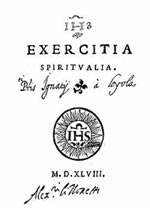
Exercitia spiritualia (Spiritual Exercises)
of Ignatius of Loyola 1548
First Edition by Antonio Bladio (Rome)Vermeer's precise motivation for painting this work is difficult to determine. Although rejected by modern scholars, it was once believed that he was apprenticed with Leonaert Bramer, a Catholic and close friend to the Vermeer family in Delft. Bramer was the most prestigious figure in Delft painting at the time and was known to have traveled to Italy. Particularly revealing is the elder artist's intercession on behalf of the young painter in his betrothal to Catharina Bolnes, the daughter of the well-to-do Delft patrician, Maria Thins. Bramer may have sealed the bargain by guaranteeing the young painter's future and a quick conversion to Catholicism, a rare event in 17th-century Netherlands. Just the same, no records have survived which mention Vermeer's apprenticeship and his first works have almost nothing in common with Bramer's.
In any case, it has been hypothesized that Vermeer's Christ in the House of Martha and Mary is a sign of his classical training combined with a newfound Catholic sentiments although the picture may have been commissioned by someone particularly interested in the motif.
Martha and Mary represented two opposing personalities: the active and the contemplative. Christ's defense of the contemplative life suited Jesuit ideals and was contained within the Spiritual Exercises of Ignatius of Loyola. Vermeer's treatment of this subject, which focuses on the message that Christ is transmitting, may reflect his sympathetic response to the Catholic Church in the mid-1650s. Vermeer's mother-in-law, Maria Thins, maintained close contacts to the Jesuits in Delft.
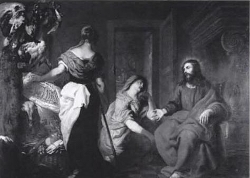
Christ in the House of Martha and Mary
Erasmus Quellinus
c. 1645
Oil on canvas, 175 x 243 cm.
Musée des Beaux Arts, ValenciennesIn no other painting did Vermeer focus so exclusively on the figures. Within a few years, he became absorbed in the relationship of the figure to the environment. Here dark background serves only to emphasize the figural relationships rather than reveal something about their story or lives.
Numerous visual sources were available to the young Vermeer for this composition. The most likely model was a work by the Fleming Erasmus Quellinus (Musée des Beaux Arts, Valenciennes).
Some Vermeer writers place the Diana and her Companions immediately before his Christ in the House of Martha and Mary and others after. Unless the state of conservation of the Diana has suffered more than can be determined, its technical level is far inferior to the Christ making the Diana Vermeer's first work.
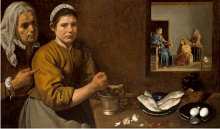
Кухня Сцена со Христом в
Дом Марфы и Марии
Diego Velásquez
Oil on canvas, 63 x 103.5 cm.
National Gallery, LondonВ Северной Европе, но не только, мотив визита Христа к Марфе и Марии, вдохновила многих картин, которые были в сущности едва завуалированной натюрморты.Наиболее прославленный южных европейских примером является версия Диего Веласкеса (см слева). Вот испанского мастера щедро большое внимание на двух фигурах бодегонес на переднем плане и на кухонной утвари и продуктов питания, вероятно, взяты из собственных условий жизни художника. Отнесенных к вторичной роли, религиозная сцена происходит в то, что, кажется, прозрачный окно из деревенской кухни, которая почти можно принять за обрамленное изображение..
Ближе к дому, версия Питер де Bloot в (см связанных изображений нет. 4 ниже) показывает, расползание кухня сцену, которая, несомненно, отражается голландский озабоченность домашними делами и внутренний силу, а не явного приверженности духовным вопросам..
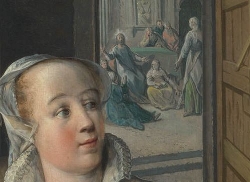
Четыре стихии: Огонь (detail)
Joachim Beuckelaer
1570
Oil on canvas, 157.5 x 215.5 cm.
National Gallery, LondonОдной из самых необычных исполнений Христа в доме Марфы и Марии тему Иоахим Beuckelaer в огонь, одна работа из набора четырех картин, которые берут как их темы четырех элементов "Землю", "Вода", "Воздух" и "Огонь". В каждой соблазнительной представления товарной продукции для продажи или для приготовления пищи в сочетании с библейскими эпизодами. В огне, современные зрители озадачены значение, придаваемое мирской кухни сцены в отношениях с крошечной библейской сцены, отнесенные к дальней точки сложной пространственной конструкции картины (см деталь слева).
В религиозном контексте времени, рассказ о Марфе и Марии показано одно из основных различий, стоящих перед католики и протестанты.Последнее искал спасение в действии в то время бывший размещены большее значение созерцательной жизни. Вот Beuckelaer предает учение о божественном слове к задней части живописи, посвятив всю передний план к активной жизни..

Bathsheba
Jacob van Loo
c.1650
Oil on canvas, 81 x 68 cm.
Musée du Musée du Louvre, ParisAlthough the Bible had been one of the most important sources of inspirations for European painters by the mid-17th century, still life, portraiture, landscape and interiors had largely replaced traditional religious and historical subjects in the Netherlands. Just the same, contemporary art theorists still defended the intellectual and moral superiority of istoria, or history painting (see example left) and many of the most ambitious painters, like Rembrandt, devoted their energies to its mastery.
History painting offered uplifting or cautionary narratives that were intended to encourage contemplation of the meaning of life. It also satisfied a desire for religious imagery that remained strong, even after most traditional religious pictures had been removed from Calvinist churches in the wave of iconoclasts destroying a great part of the early Dutch pictorial heritage.
For unknown reasons Vermeer soon abandoned history painting and embraced the "modern" mode of painting practiced by celebrated artists like Gerrit ter Borch, Gerrit Dou and Frans van Mieris. Vermeer would only take up the religious motif again in the late Allegory of Faith, a full-fledged religious work set in a Dutch 17th-century interior, a somewhat awkward combination of the two modes of painting, at least for modern sensibilities.
From the onset of his career Vermeer was keenly aware of the expressive role of composition in his art. In order to understand how effectively he employed composition in the present work, it is necessary to be familiar with the religious implications of the Christ in the house of Martha and Mary theme in 17th-century Netherlands.
Commentators on this famous biblical story had long recognized the contrast between the active life of Martha (who complains to Christ about her sister's lack of help in domestic chores) and Mary's contemplative nature (who passively attends to the words of Christ neglecting Martha's call for help). The sisters had been traditionally identified as symbols of opposing paths of salvation. Martha represented the necessities of performing good works while Mary shuns earthly concerns and puts all her faith in the message of eternal life promised by Christ. This story illustrates one of the central debates between the Protestant and Catholic religious cults.
For Protestant reformers the story supported the fact that salvation can be obtained by adopting the belief in forgiveness of sin by a merciful God earned by Christ's Crucifixion. Roman Catholics, on the other hand, emphasized not only salvation by faith in God but by proper action. For the latter, salvation could be earned through acts of humility and good works. Although Christ did define Mary's contemplative role as the "better half," Catholics pointed out that Mary's faith would be incomplete without an active life.
By stressing certain elements of the composition or playing down others and organizing the positions of each, an artist is able to manipulate the meaning of the parable in favor of one or the other point of view. It has been frequently remarked that Vermeer balanced the two figures of Martha and Mary in the composition giving equal compositional weight to each. On the picture plane, both touch Christ and all three of the figures are invisibly bound in an imaginary circle further enhancing their unity. It would appear that Vermeer was aware of the conflict between the Protestant and Catholic positions and attempted a synthesis in his painting through a reconciliatory balance.

Christ in the House of Mary and Martha
Jacopo Tintoretto
c. 1580
Oil on canvas, 200 x 132 cm.
Alte Pinakothek, MünchenEven in his first works, Vermeer clearly demonstrated his ability to draw visual, technical and intellectual inspiration from a variety of sources and weave them together with originality. This work draws upon sources as diverse as Italian and Netherlandish painting.
Although hidden to the untrained eye the three figures are bound in a circular composition (see Special Topic above) unifying theme and composition. Circular compositions were frequently employed to unite complex figure groupings and impede the viewer's eye from straying aimlessly around the picture. Curiously, Tintoretto's own Christ in the House of Martha and Mary, painted about 70 years earlier than Vermeer's version, presents one of the most noticeable circular compositions in European art.
Although the circular composition may be an effective way of controlling the viewer's attention, if it is too influential, the observer feels subliminally entrapped. As a remedy artists often included a sort of escape route such as the background scenes in Tintoretto's painting. Vermeer provided a similar visual relief in the half-opened doorway to the dark recess of the upper left-hand corner of the composition. Some of the most powerful works of Western art have circular compositions.

Saint Sebastian Tended by Irene and her Maid
Hendrick ter Brugghen
1625
Oil on canvas, 149 x 119.4 cm.
Allen Memorial Art Museum, Oberlin, OhioIn his formative years, Vermeer surveyed a wider range of artistic possibilities and combined them together with his innate sense of measure and moral seriousness.
Among Dutch paintings related to Vermeer's Christ in the House of Martha and Mary is the Saint Sebastian Tended by Irene and her Maid by Hendrick ter Brugghen with its tight figural composition. While this comparison is certainly relevant, the young Vermeer may have also been impressed by other aspects of Ter Brugghen's art as well, such as his control of light and masterful simplicity of modeling. Although the brushwork of the legendary Frans Hals and Rembrandt more readily engage the eye, Ter Brugghen's manipulation of paint with brush is among the most powerful in European easel painting and not overlooked in his time. When visiting Amsterdam, the great Peter Paul Rubens, Europe's foremost painter, visited Ter Brugghen's studio while passing by even that of Rembrandt.
In Ter Brugghen's Saint Sebastian, form is masterfully conjured up by sweeping brushtrokes of juicy paint. Only such a level of technique can make painting seem like a natural activity. When painting the head and headgear of the kneeling Mary, the receptive young Vermeer may have wished to imitate the compactness of the illuminated head in the central figure in Ter Brugghen's composition. He may have understood that only broad, robust brushwork could hold together such a large-scale composition while conferring the gravity and stillness he strove for.
Dress has always played an important part in history painting and portraiture. One of the cardinal principles of a traditional history painting, such as the present work by Vermeer, is that contemporary dress must be avoided at all costs. This was in part because most historical figures could be recognized by a traditional dress and in part because contemporary fashion was thought to be unsuitable for expressing the universal principles worthy of what art theorists considered the uppermost goal of painting.
However, there was no precise agreement as to exactly what dress constituted the most appropriate for history painting. Costume expert Marieke van Winkel observed that art theorists provided general prescriptions for the proper clothes (and even colors) for the most important protagonists. Kings, for example, of any time or age, should wear a medieval crown and ermine cloak and youth should wear brightly colored clothing. However, as much as art theorists attempted to guide the artists's hands and urged them to consult texts of the Classics, each painter solved the problem of visualizing an unknown past in a different way. In reality, ancient texts provided scant details that would be of practical help and the Bible, one of the principal sources of history painting motifs, is completely silent in this regards.
In general, simple, loose costumes with billowing drapery that cannot be pin-pointed to a particular time or place were favored because they offer latitude for painterly interpretation and per se evoked a sense of timelessness. Although a painter might add accessories from his own collection, most worked from their imagination or prints of Old Master paintings. In any case, a certain flowing naturalness was one of the requisite qualities of any depiction of drapery.
Vermeer followed classical dress traditions in the Christ in the House of Martha and Mary although the costume of the standing Martha seems to hint at contemporary dress. Mary's clothes have a particularly sober substance while the clothes of Christ appear somewhat unsubstantial with little or no attention paid to the tuck and fold of the fabrics.
Johann Sebastian Bach
Recitativo, Siehe, ich stehe vor der Tür (Behold, I stand at the door) (1.48 MB)
from cantata BWV 61 Nun komm, der Heiden Heiland
http://www.amazon.de/Kantaten-BWV-140-61-36/dp/B0000035PF/ref=sr_1_22?ie=UTF8&s=music&qid=1258281314&sr=1-22Siehe, ich stehe vor der Tür und klopfe an.
So jemand meine Stimme hören wird und
die Tür auftun, zu dem werde ich eingehen
und das Abendmahl mit ihm halten
und er mit mir.Behold, I stand at the door and knock.
If anyone hears My voice and
opens the door, I will come in to him
and will dine with him,
and he with Me.(Revelation 3,20; version American Standard Bible 1993)




